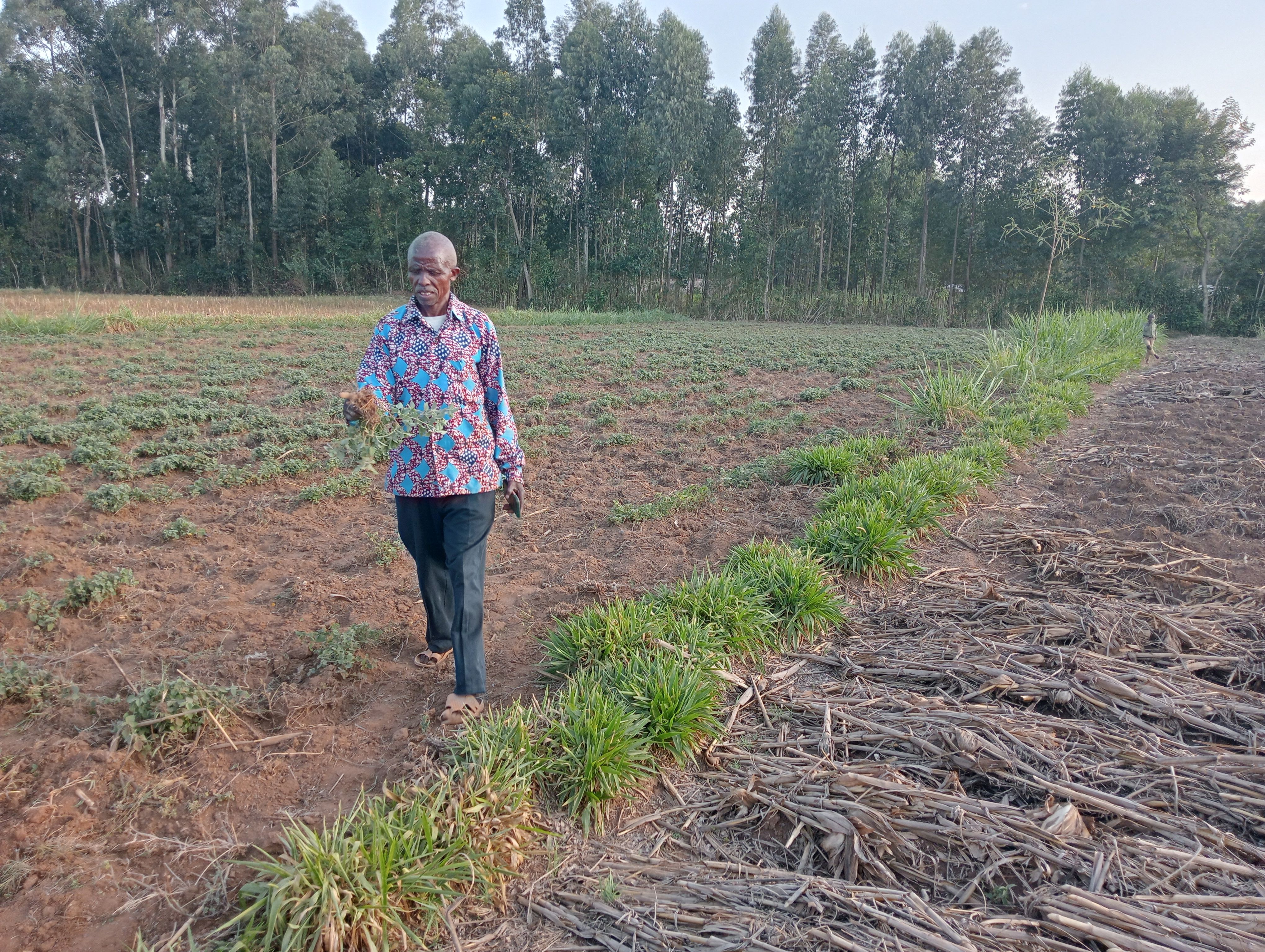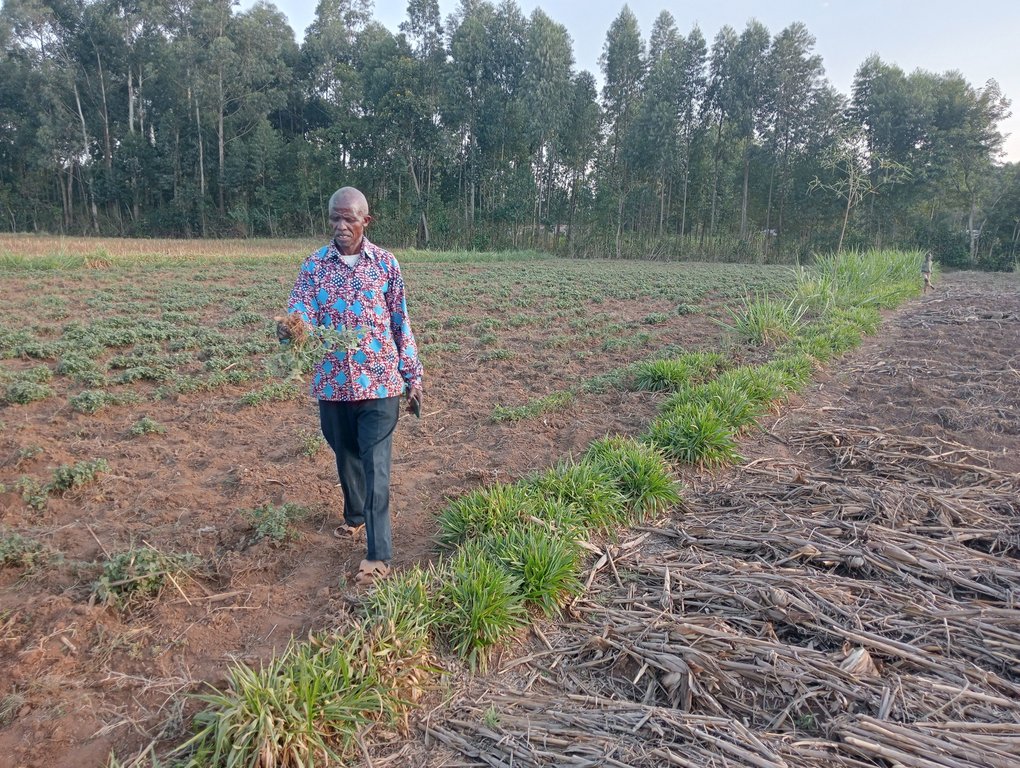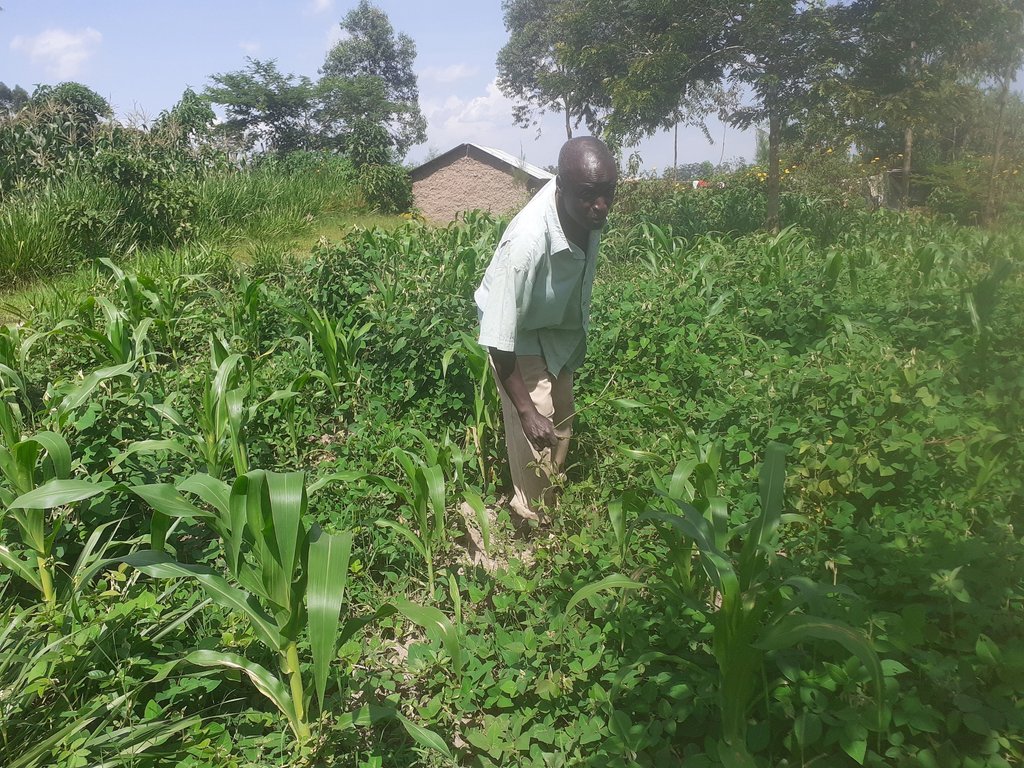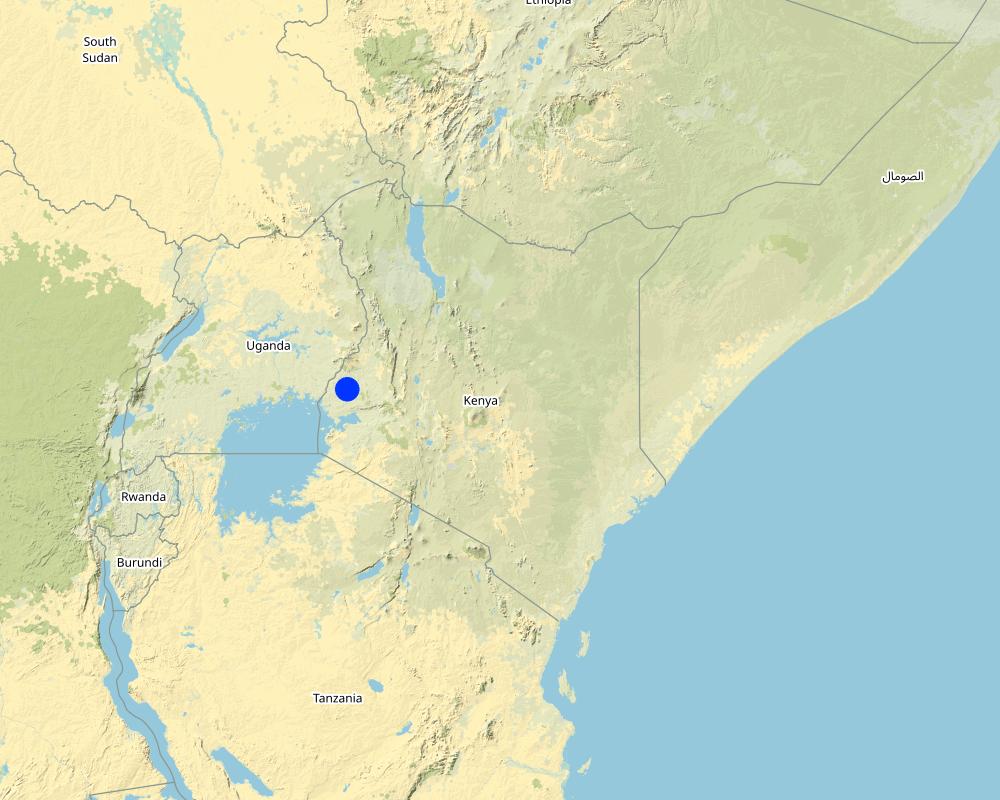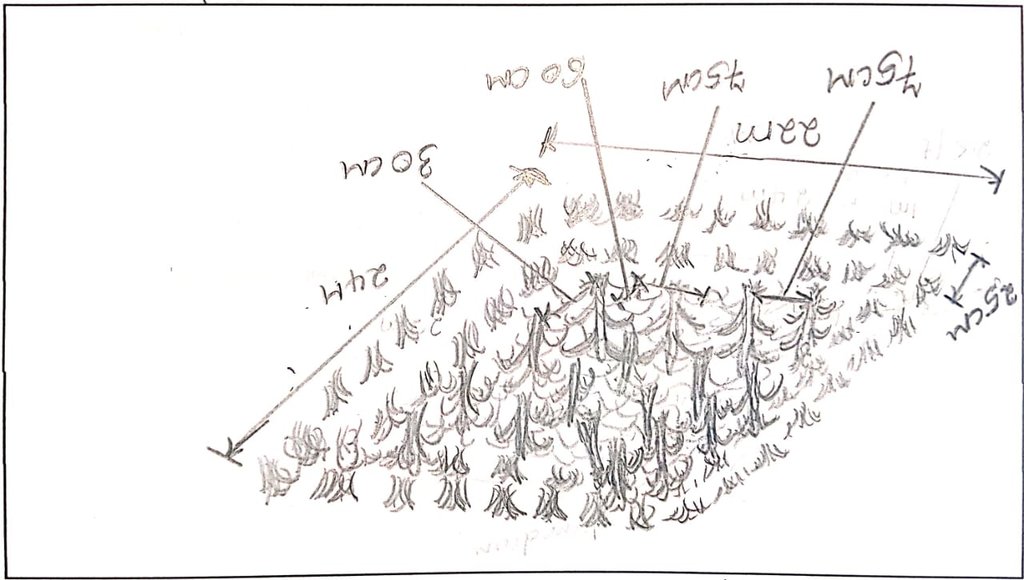Push-pull crop pest control [肯尼亚]
- 创建:
- 更新:
- 编制者: William Akwanyi
- 编辑者: George Onyango, Innocent Faith, Noel Templer, JUSTINE OTSYULA
- 审查者: William Critchley, Rima Mekdaschi Studer
technologies_6701 - 肯尼亚
查看章节
全部展开 全部收起1. 一般信息
1.2 参与该技术评估和文件编制的资源人员和机构的联系方式
关键资源人
土地使用者:
Keya Andrew Mulaa
Welthungerhilfe farmer
肯尼亚
SLM专业人员:
SLM专业人员:
有助于对技术进行记录/评估的项目名称(如相关)
Soil protection and rehabilitation for food security (ProSo(i)l)有助于对技术进行记录/评估的机构名称(如相关)
Deutsche Gesellschaft für Internationale Zusammenarbeit (GIZ)有助于对技术进行记录/评估的机构名称(如相关)
Alliance Bioversity and International Center for Tropical Agriculture (Alliance Bioversity-CIAT) - 肯尼亚1.3 关于使用通过WOCAT记录的数据的条件
编制者和关键资源人员接受有关使用通过WOCAT记录数据的条件。:
是
1.4 所述技术的可持续性声明
这里所描述的技术在土地退化方面是否存在问题,导致无法被认为是一种可持续的土地管理技术?:
否
注释:
The technology has not adversely affected the farms of farmers who have implemented the technology.
2. SLM技术的说明
2.1 技术简介
技术定义:
Push-pull technology is a strategy that controls pests, improves the productivity of cereal crops and fodder, and controls soil erosion.
2.2 技术的详细说明
说明:
Push–pull technology was developed by the International Centre of Insect Physiology and Ecology (ICIPE) in collaboration with Rothamsted Research, (UK) in Kenya in the 1990s for the control of stemborer and striga weed in resource-poor maize farming systems. It is a strategy for controlling pests by using plants that repel them i.e., “push” crops and plants that trap pests i.e., “pull” crops. In Kakamega, Siaya, and Bungoma counties of western Kenya (i.e., the ProSoil project areas), the production of maize, millet, and sorghum has greatly been affected by poor soil fertility; insect pests, especially stemborer; and a parasitic weed called striga. Under the ProSoil project, Desmodium intortum is the main repellent “push” crop while napier grass (Pennisetum purpureum), brachiaria (Brachiaria decumbens), and mulatto (Brachiaria ruziziensis) are the main “pull” or trap plants.
In a typical push-pull system, the attractant “pull” plant is planted as a border around the field where the main crop e.g., maize, millet, or sorghum has been intercropped with the “push” crop. Desmodium produces repellent volatile chemicals that push away stemborer moths from the main field towards the edge where there is the “pull” or trap crop. The attractant trap plant emits volatile compounds which serve as a haven for the stemborers. As the stemborer moths lay eggs on the pull/ trap plant (in this case bracharia) and the eggs hatch and develop into larvae or caterpillar stage, a sticky substance like glue secreted by the bracharia physically traps the larvae; hence, inhibiting further development. In addition, desmodium stimulates the germination of striga and then effectively inhibits its growth through its roots' exudates.
“Push-pull” technology improves the productivity of cereal crops, controls soil erosion, and contributes to conservation agriculture (minimum tillage). Desmodium and bracharia are both high-quality animal fodder plants and because of their perennial nature, they maintain ground cover. Bracharia is rich in crude protein. Desmodium is a leguminous green manure cover crop and, therefore, it fixes nitrogen in the soil and improves soil organic matter. Desmodium does not suppress the main crop since it is not a climber.
One acre (0.4 ha) of land (in a push-pull system) requires about 0.75 kg of desmodium seeds and about 0.5 kg of brachiaria seeds. Desmodium is planted at a spacing of 75 cm between rows and 60 cm between plants in the same row. The cereal crop is established in rows parallel to the desmodium crop rows (e.g., 75 cm from row to row and 30 cm from plant to plant in the same row for maize). Brachiaria is planted in two shallow trenches (50 cm apart) and because the seeds are very tiny, they are sown on the surface of the trenches and covered with a very thin layer of soil to keep them in place, in darkness, until they sprout. They are later thinned to give a spacing of 25 cm between plants.
2.3 技术照片
2.4 技术视频
注释、简短说明:
https://www.youtube.com/watch?v=QbX1RWBGZI4&ab_channel=WilliamOnura
A farmer demonstrating how to prune desmodium roots using an African sword and how to break the ground/ soil using a chaka hoe.
日期:
11/02/2023
位置:
Andrew Mulla's farm in Lunyu Village, Khalaba Ward, Matungu Sub-county, in Kakamega County
摄影师的名字:
William Akwanyi
2.5 已应用该技术的、本评估所涵盖的国家/地区/地点
国家:
肯尼亚
区域/州/省:
Kakamega County in western Kenya
有关地点的进一步说明:
Khalaba Ward, Matungu Sub-county, in Kakamega County
具体说明该技术的分布:
- 均匀地分布在一个区域
如果不知道精确的区域,请注明大致覆盖的区域:
- < 0.1 平方千米(10 公顷)
技术现场是否位于永久保护区?:
否
注释:
There are no protected areas in the areas covered by this assessment. The stated area is the total area of the two fields where the information that was used in this documentation was collected from. Only one field (Andrew's) was used for most of the documentation e.g., field measurements and costs estimation. Nice photos of the technology were taken in the other field (Patrick's).
Map
×2.6 实施日期
注明实施年份:
2019
2.7 技术介绍
详细说明该技术是如何引入的:
- 通过项目/外部干预
注释(项目类型等):
Technology introduced by the ProSoil project.
3. SLM技术的分类
3.1 该技术的主要目的
- 改良生产
- 保持/提高生物多样性
- 适应气候变化/极端天气及其影响
- 减缓气候变化及其影响
- 创造有益的经济影响
3.2 应用该技术的当前土地利用类型
同一土地单元内混合使用的土地::
是
具体说明混合土地使用(作物/放牧/树木):
- 农林牧业

农田
- 一年一作
- 多年一作(非木材)
- 乔木与灌木的种植
年作 - 具体指明作物:
- 谷物类 - 玉米
- 谷类 - 高粱
- 饲料作物 - 三叶草
- 饲料作物 - 草
- 豆科牧草和豆类 - 豆子
- 蔬菜 - 其他
年作制度:
玉米/高粱/谷子与豆类间作
多年生(非木质)作物 - 指定作物:
- 香蕉/芭蕉/蕉麻
- 饲料作物 - 草
- fodder crops - legumes, clover
- 甘蔗
乔木和灌木种植 - 指定作物:
- 鳄梨
- 饲料树木(朱缨花属、银合欢、前庭草等)
- 水果、其他
- 芒果、山竹果、番石榴
- 木瓜
每年的生长季节数:
- 2
具体说明:
Crops are grown during the long and short rain seasons.
采用间作制度了吗?:
是
如果是,说明哪些作物是间作的:
Cereal and legumes.
采用轮作制度了吗?:
是
如果是,请具体说明:
The push-pull plot is left fallow with only the repellant and attractant crops.

牧场
集约放牧/饲料生产:
- 收割和携带/零放牧
- 改良牧场
动物类型:
- 牛 - 奶制品
- 山羊
- 家禽
是否实行作物与牲畜的综合管理?:
是
如果是,请具体说明:
Desmodium and napier grass are fodder crops - fed to livestock. Manure from the animals is applied on the cereal crops.
产品和服务:
- economic security, investment prestige
- 蛋类
- manure as fertilizer/ energy production
- 肉类
- 奶类
品种:
牛 - 奶制品
计数:
3
品种:
家禽
计数:
55
品种:
山羊
计数:
4
3.3 由于技术的实施,土地使用是否发生了变化?
由于技术的实施,土地使用是否发生了变化?:
- 否(继续问题3.4)
3.4 供水
该技术所应用土地的供水:
- 雨养
注释:
Crop establishment is dependent on availability of rainfall.
3.5 该技术所属的SLM组
- 轮作制度(轮作、休耕、轮垦)
- 农畜综合管理
- 病虫害综合管理(包括有机农业)
3.6 包含该技术的可持续土地管理措施

农艺措施
- A1:植被和土壤覆盖层
- A2:有机质/土壤肥力
- A3:土壤表面处理

植物措施
- V2:草和多年生草本植物
3.7 该技术强调的主要土地退化类型

土壤水蚀
- Wt:表土流失/地表侵蚀

土壤风蚀
- Et:表土流失
3.8 防止、减少或恢复土地退化
具体数量名该技术与土地退化有关的目标:
- 防止土地退化
4. 技术规范、实施活动、投入和成本
4.1 该技术的技术图纸
技术规范(与技术图纸相关):
Trap crop at the edge (brachiaria): 50 cm x 25 cm
Repellant crop (desmodium): 75 cm x 60 cm
Cereal crop (maize intercropped with desmodium): 75 cm x 30 cm
作者:
William Akwanyi
日期:
11/02/2023
4.2 有关投入和成本计算的一般信息
具体说明成本和投入是如何计算的:
- 每个技术区域
注明尺寸和面积单位:
0.0528 ha
其它/国家货币(具体说明):
KES
如相关,注明美元与当地货币的汇率(例如1美元=79.9巴西雷亚尔):1美元=:
124.21
注明雇用劳工的每日平均工资成本:
KES 250.00
4.3 技术建立活动
| 活动 | 时间(季度) | |
|---|---|---|
| 1. | Land preparation | Before rains |
| 2. | Seed sourcing | Before rains |
| 3. | Planting | After rains |
注释:
Land should be ploughed only when there are stubborn weeds.
4.4 技术建立所需要的费用和投入
| 对投入进行具体说明 | 单位 | 数量 | 单位成本 | 每项投入的总成本 | 土地使用者承担的成本% | |
|---|---|---|---|---|---|---|
| 劳动力 | Land preparation | Man-days | 4.0 | 250.0 | 1000.0 | 100.0 |
| 设备 | Slasher | No. | 1.0 | 70.0 | 70.0 | |
| 设备 | African machete (panga) | No. | 1.0 | 80.0 | 80.0 | |
| 设备 | Jab planter | No. | 1.0 | 1000.0 | 1000.0 | |
| 植物材料 | Bracharia seeds | Kgs | 0.1 | 420.0 | 42.0 | |
| 植物材料 | Desmodium seeds | Kgs | 0.26 | 420.0 | 109.2 | |
| 植物材料 | Maize seeds | Kgs | 1.0 | 180.0 | 180.0 | 100.0 |
| 肥料和杀菌剂 | Manure | Wheelbarrows | 30.0 | 70.0 | 2100.0 | |
| 技术建立所需总成本 | 4581.2 | |||||
| 技术建立总成本,美元 | 36.88 | |||||
如果土地使用者负担的费用少于100%,请注明由谁负担其余费用:
ProSoil project through Welthungerhilfe.
注释:
The ProSoil project through Welthungerhilfe provided slashers, African swords, and jab planters to the farmers through their groups. The costs of these implements are KES 350/- for a slasher, KES 400/- for a panga (machete), and KES 5,000/- for a jab planter. It is assumed that the farmer will be able to use these implements over a period of 5 years before these implements will have depreciated to a point where they will not be useable. The cost is thus spread over the years when the farmer will be able to use the implement.
4.5 维护/经常性活动
| 活动 | 时间/频率 | |
|---|---|---|
| 1. | Shallow weeding | Twice during maize crop growing period |
| 2. | Ripping | Before maize re-establishement |
| 3. | Root management | Before maize re-establishement |
4.6 维护/经常性活动所需要的费用和投入(每年)
| 对投入进行具体说明 | 单位 | 数量 | 单位成本 | 每项投入的总成本 | 土地使用者承担的成本% | |
|---|---|---|---|---|---|---|
| 劳动力 | Shallow weeding | Man-days | 2.0 | 250.0 | 500.0 | |
| 劳动力 | Root management | Man-days | 2.0 | 250.0 | 500.0 | |
| 劳动力 | Ripping | Man-days | 4.0 | 250.0 | 1000.0 | |
| 设备 | Shallow weeder | No. | 1.0 | 80.0 | 80.0 | |
| 设备 | Chaka hoe | No. | 1.0 | 130.0 | 130.0 | |
| 设备 | African machete (panga) | No. | 1.0 | 80.0 | 80.0 | |
| 技术维护所需总成本 | 2290.0 | |||||
| 技术维护总成本,美元 | 18.44 | |||||
如果土地使用者负担的费用少于100%,请注明由谁负担其余费用:
ProSoil project through Welthungerhilfe.
注释:
The ProSoil project through Welthungerhilfe provided Shallow weeders, pangas (machete), and chaka hoes to the farmers through their groups. The costs of these implements are KES 400/- for a slasher, KES 400/- for an African sword, and KES 650/- for a jab planter. It is assumed that the farmer will be able to use these implements over a period of 5 years before these implements will have depreciated to a point where they will not be useable. The cost is thus spread over the years when the farmer will be able to use the implement.
4.7 影响成本的最重要因素
描述影响成本的最决定性因素:
Rate of man-days vary from one place to another, farmer to farmer, and with type of work.
Exchange rate for February 2023, source: European Commission/ InfoEuro online at https://commission.europa.eu/funding-tenders/procedures-guidelines-tenders/information-contractors-and-beneficiaries/exchange-rate-inforeuro_en
5. 自然和人文环境
5.1 气候
年降雨量
- < 250毫米
- 251-500毫米
- 501-750毫米
- 751-1,000毫米
- 1,001-1,500毫米
- 1,501-2,000毫米
- 2,001-3,000毫米
- 3,001-4,000毫米
- > 4,000毫米
指定年平均降雨量(若已知),单位为mm:
1300.00
有关降雨的规范/注释:
Monthly rainfall variability is high with some months such as January recording less than 5 mm of total rainfall.
注明所考虑的参考气象站名称:
Kakamega Meteorological Station
农业气候带
- 潮湿的
The climate in the area favours most agricultural activities.
5.2 地形
平均坡度:
- 水平(0-2%)
- 缓降(3-5%)
- 平缓(6-10%)
- 滚坡(11-15%)
- 崎岖(16-30%)
- 陡峭(31-60%)
- 非常陡峭(>60%)
地形:
- 高原/平原
- 山脊
- 山坡
- 山地斜坡
- 麓坡
- 谷底
垂直分布带:
- 0-100 m a.s.l.
- 101-500 m a.s.l.
- 501-1,000 m a.s.l.
- 1,001-1,500 m a.s.l.
- 1,501-2,000 m a.s.l.
- 2,001-2,500 m a.s.l.
- 2,501-3,000 m a.s.l.
- 3,001-4,000 m a.s.l.
- > 4,000 m a.s.l.
说明该技术是否专门应用于:
- 不相关
5.3 土壤
平均土层深度:
- 非常浅(0-20厘米)
- 浅(21-50厘米)
- 中等深度(51-80厘米)
- 深(81-120厘米)
- 非常深(> 120厘米)
土壤质地(表土):
- 中粒(壤土、粉土)
土壤质地(地表以下> 20厘米):
- 中粒(壤土、粉土)
表土有机质:
- 中(1-3%)
如有可能,附上完整的土壤描述或具体说明可用的信息,例如土壤类型、土壤酸碱度、阳离子交换能力、氮、盐度等。:
Soil pH was 4.8 before push-pull was implented.
5.4 水资源可用性和质量
地下水位表:
5-50米
地表水的可用性:
中等
水质(未处理):
良好饮用水
水质请参考::
地下水
水的盐度有问题吗?:
否
该区域正在发生洪水吗?:
否
关于水质和水量的注释和进一步规范:
There are several boreholes in the area and according to interviews with some borehole owners, the depths are not more than 50 metres.
5.5 生物多样性
物种多样性:
- 高
栖息地多样性:
- 高
关于生物多样性的注释和进一步规范:
Most farms are under crops and trees therefore the agrobiodiversity is high.
5.6 应用该技术的土地使用者的特征
定栖或游牧:
- 定栖的
生产系统的市场定位:
- 混合(生计/商业)
非农收入:
- > 收入的50%
相对财富水平:
- 平均水平
个人或集体:
- 个人/家庭
机械化水平:
- 手工作业
性别:
- 女人
- 男人
土地使用者的年龄:
- 青年人
- 中年人
- 老年人
5.7 应用该技术的土地使用者使用的平均土地面积
- < 0.5 公顷
- 0.5-1 公顷
- 1-2 公顷
- 2-5公顷
- 5-15公顷
- 15-50公顷
- 50-100公顷
- 100-500公顷
- 500-1,000公顷
- 1,000-10,000公顷
- > 10,000公顷
这被认为是小规模、中规模还是大规模的(参照当地实际情况)?:
- 中等规模的
5.8 土地所有权、土地使用权和水使用权
土地所有权:
- 个人,未命名
- 个人,有命名
土地使用权:
- 租赁
- 个人
用水权:
- 社区(有组织)
土地使用权是否基于传统的法律制度?:
否
注释:
The farmer has a title for his piece of land. He also leases other people's pieces of land for farming. Water in the streams and springs is freely accessed with restrictions.
5.9 进入服务和基础设施的通道
健康:
- 贫瘠
- 适度的
- 好
教育:
- 贫瘠
- 适度的
- 好
技术援助:
- 贫瘠
- 适度的
- 好
就业(例如非农):
- 贫瘠
- 适度的
- 好
市场:
- 贫瘠
- 适度的
- 好
能源:
- 贫瘠
- 适度的
- 好
道路和交通:
- 贫瘠
- 适度的
- 好
饮用水和卫生设施:
- 贫瘠
- 适度的
- 好
金融服务:
- 贫瘠
- 适度的
- 好
注释:
The above rating varies from one village to the other.
6. 影响和结论性说明
6.1 该技术的现场影响
社会经济效应
生产
作物生产
SLM之前的数量:
2
SLM之后的数量:
5
注释/具体说明:
Quantity refers to the number of 90 Kg bags of maize produced per acre. Based on the farmer's experience.
作物质量
注释/具体说明:
Not easy to quantify. The crops do better compared to the past. Based on the farmer's estimate.
饲料生产
SLM之前的数量:
0
SLM之后的数量:
10
注释/具体说明:
Quantity refers to amount of bracharia and desmodium in tonnes per year. Based on the farmer's estimate.
饲料质量
注释/具体说明:
Not easy to quantify. Fodder does better compared to how it was before the technology. Based on the farmer's estimate.
畜牧生产
SLM之前的数量:
2
SLM之后的数量:
8
注释/具体说明:
Quantity refers to the amount of milk in litres from one cow. Based on the farmer's estimate.
生产故障风险
SLM之前的数量:
70
SLM之后的数量:
30
注释/具体说明:
Quantity refers to the percentage probability of the crop failing to do well. Based on the farmer's estimate.
土地管理
注释/具体说明:
Not easy to quantify but it is easier to prepare land through no tillage than to plough. Based on the farmer's estimate.
收入和成本
农业投入费用
SLM之前的数量:
7,000
SLM之后的数量:
0
注释/具体说明:
Quantity refers to the amount of money in Kenya shillings spend on inorganic fertilizers in a season. The farmer no longer buys money inorganic fertilizers.
农业收入
SLM之前的数量:
1,000
SLM之后的数量:
15,000
注释/具体说明:
Quantity refers to amount of money from farming per year.
收入来源的多样性
SLM之前的数量:
2
SLM之后的数量:
4
注释/具体说明:
Quantity refers to the number of household income sources. Based on the farmer's estimate.
工作量
注释/具体说明:
Not easy to quantify but it is easier to prepare land through no tillage than to plough. Based on the farmer's estimate.
社会文化影响
食品安全/自给自足
SLM之前的数量:
1
SLM之后的数量:
0
注释/具体说明:
Quantity refers to the number of months in a year when there is total lack of food in the house, and the farmer has to buy all the food required in the house.
SLM/土地退化知识
SLM之前的数量:
20
SLM之后的数量:
80
注释/具体说明:
Quantity refers to the estimated percentage of knowledge in SLM/ land management. Based on the farmer's estimate. He says his SLM knowledge has greatly increased.
生态影响
土壤
土壤水分
SLM之前的数量:
10
SLM之后的数量:
30
注释/具体说明:
Quantity refers to the farmer's estimated soil moisture content during the dry season when soil moisture challenges are expected to be high.
土壤覆盖层
SLM之前的数量:
20
SLM之后的数量:
70
注释/具体说明:
Quantity refers to the farmer's estimated percentage soil cover at the farm.
土壤流失
注释/具体说明:
Not easy for the farmer to quantify. Based on the farmer's estimate. Soil erosion has been controlled to some considerable degree at the farm.
土壤堆积
注释/具体说明:
Not easy for the farmer to quantify. Based on the farmer's estimate.
土壤有机物/地下C
SLM之前的数量:
20
SLM之后的数量:
60
注释/具体说明:
Quantity refers to the farmer's estimated percentage of organic matter at the farm.
生物多样性:植被、动物
植被覆盖
SLM之前的数量:
30
SLM之后的数量:
60
注释/具体说明:
Quantity refers to the farmer's estimated percentage vegetation cover at the farm.
植物多样性
SLM之前的数量:
6
SLM之后的数量:
20
注释/具体说明:
Quantity refers to the number of plants (crops) that the farmer establishes at the farm.
栖息地多样性
注释/具体说明:
Not easy for the farmer to quantify. The number of plants at the farm has increased.
对现场影响的评估(测量)进行具体说明:
No recorded data is available for reference. All are estimates based on the farmer's explanation or as given by him.
6.2 该技术的场外影响已经显现
缓冲/过滤能力
注释/具体说明:
Not easy for the farmer to quantify.
6.3 技术对渐变气候以及与气候相关的极端情况/灾害的暴露和敏感性(土地使用者认为的极端情况/灾害)
渐变气候
渐变气候
| 季节 | 增加或减少 | 该技术是如何应对的? | |
|---|---|---|---|
| 年温度 | 增加 | 好 | |
| 季节性温度 | 旱季 | 增加 | 好 |
气候有关的极端情况(灾害)
生物灾害
| 该技术是如何应对的? | |
|---|---|
| 昆虫/蠕虫侵扰 | 非常好 |
6.4 成本效益分析
技术收益与技术建立成本相比如何(从土地使用者的角度看)?
短期回报:
非常积极
长期回报:
非常积极
技术收益与技术维护成本/经常性成本相比如何(从土地使用者的角度看)?
短期回报:
非常积极
长期回报:
非常积极
6.5 技术采用
- 1-10%
在所有采用这项技术的人当中,有多少人是自发的,即未获得任何物质奖励/付款?:
- 91-100%
6.6 适应
最近是否对该技术进行了修改以适应不断变化的条件?:
否
6.7 该技术的优点/长处/机会
| 土地使用者眼中的长处/优势/机会 |
|---|
| Controls pests and weeds (striga). |
| Controls soil erosion. |
| Reduces workload due to permanent cover on the soil - minimum tillage. |
| Desmodium does not interfere with the cereal crop. |
6.8 技术的弱点/缺点/风险及其克服方法
| 土地使用者认为的弱点/缺点/风险 | 如何克服它们? |
|---|---|
| Can be problematic if desmodium roots are not managed. | Root pruning before cereal crop establishment. |
7. 参考和链接
7.1 信息的方法/来源
- 实地考察、实地调查
Visit to two farms, only one farmer provided farm-based information used for this documentation.
- 与土地使用者的访谈
One farmer interviewed at his farm. Follow-up questions on phone.
- 与SLM专业人员/专家的访谈
ProSoil team and project implementers from GFA consulted.
- 根据报告和其他现有文档进行编译
two online sources reviewed.
(现场)数据是什么时候汇编的?:
11/02/2023
7.2 参考可用出版物
标题、作者、年份、ISBN:
Soil cover
可以从哪里获得?成本如何?
Free download at http://www.act-africa.org/image/05SOIL~1.PDF
7.3 链接到网络上的相关信息
标题/说明:
Push-Pull Technology
URL:
http://www.icipe.org/impacts/demonstration-research-impacts-communities/push-pull-technology#:~:text=Cereals%2C%20which%20include%20maize%2C%20sorghum,sub%20Saharan%20Africa%20(SSA).
7.4 一般注释
1. Provide a function to be able to link the documented SLM to similar work that has been documented in other databases e.g., LandPortal, UNCCD, etc.
2. Some of the impacts (section 6) cannot be quantified.
链接和模块
全部展开 全部收起链接
无链接
模块
无模块


